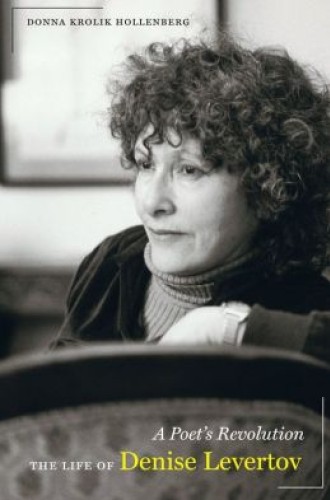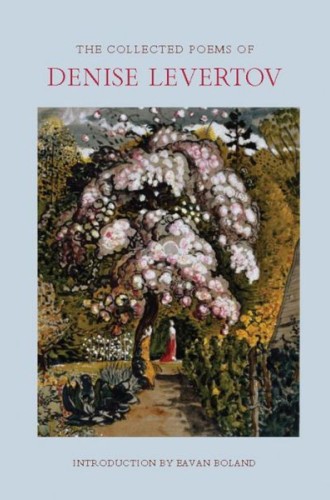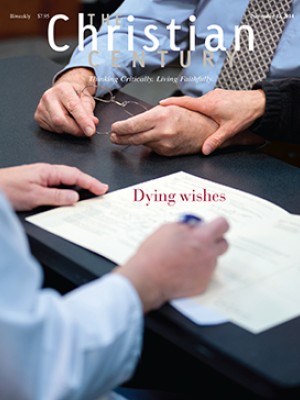The poet and politics
Writing in an effortless vernacular style, displaying deep political engagements and a mystical streak both dreamy and grounded in the physical world, Denise Levertov (1923–1997) was both a key American poet of the late 20th century and a stubborn eccentric. Levertov stood always a little apart, never at ease for long in any school or group, more than once breaking abruptly with even her closest poetic friends and mentors. With deep spiritual traditions from both sides of her family, she pursued religious issues and themes throughout her large body of work, especially after her late and somewhat uneasy conversion to Catholicism. As two new biographies and a massive collection of her poems show, this vivid, restless, and distinctive poet’s work and life remain relevant and rewarding.
Levertov was something of a prodigy, and a bold one. At age 12 she sent T. S. Eliot a letter and some poems and received an encouraging reply. Mainly educated at home in England, she served as a nurse during World War II. After the war she traveled in Europe. In Paris she met American writer and activist Mitchell Goodman; they married quickly and moved to the United States in 1948, when Levertov was pregnant with their only child, Nikolai. Levertov published her first book, The Double Image (1946), while still in her early twenties. (She changed the spelling of her name in the 1950s to distinguish herself from her sister Olga, also a published poet.)
Read our latest issue or browse back issues.
The move to America was important to her writing. She soon left behind the rather sticky neo-Romantic style of her early poems (“you will listen no more, now, to the sounding sea”). Reading and meeting William Carlos Williams, Kenneth Rexroth, Robert Duncan, and other American poets freshened her language and expanded her sense of what poems might be and do. But throughout her career Levertov maintained an essentially Romantic sensibility, a fascination with the depth, beauty, and anguish of the world, and the conviction that the poet’s vocation was to explore and evoke those mysteries through the medium of language.
These themes fit with her conscious fidelity to mystics on both sides of her family. Her father, Paul Levertoff, a Russian Jew who converted to Christianity and became a scholar and writer, was descended from a founder of Chabad Hasidism, Rabbi Schneur Zalman. Her Welsh mother, Beatrice Spooner-Jones, numbered the mystic tailor Angell Jones of Mold among her “Illustrious Ancestors.” In an early poem with that title, Levertov speaks of “thinking some line still taut between me and them” (Zalman and Jones), and of writing “poems direct as what the birds said, / hard as a floor, sound as a bench, / mysterious as the silence when the tailor / would pause with his needle in the air.”
Her biographers Dana Greene and Donna Krolik Hollenberg both had free access to the Levertov papers housed at Stanford, and both did extensive interviews and other research as well. They agree that Levertov was loyal to her family but that her relations with her parents and her gifted but troubled older sister Olga were often strained and difficult. Denise was a late child, and her father often seemed distant and preoccupied with his work.
She also did not share her mother’s earnest, conventional Christian views or her sexual prudery (Greene writes that for Beatrice Levertoff “the spirit was good and the body was a prison”). Soon after her mother moved to Mexico in the 1950s to live near the Levertovs, Denise, Mitch, and Nikolai moved back to the United States, leaving Beatrice to live with a friendly family in Oaxaca for the rest of her life.
In her journals Levertov detailed various affairs before, during, and after her marriage and wrote of her desire (often unfulfilled) to be central to someone’s life. Though she refused to call herself a feminist, her poetry speaks frankly of female desire in ways that shocked some readers. In 1964 she opened O Taste and See with the still provocative, beautifully earthy “Song for Ishtar”:
The moon is a sow
and grunts in my throat
Her great shining shines through me
so the mud of my hollow gleams
and breaks in silver bubbles
She is a sow
and I a pig and a poet
When she opens her white
lips to devour me I bite back
and laughter rocks the moon
In the black of desire
we rock and grunt, grunt and
shine
This is no lesbian anthem, though it might be read that way. Though a number of her close friends were gay men, Levertov seems to have always been uneasy about same-sex relationships between women. She criticized fellow poet Adrienne Rich, for example, for connecting feminism too closely to lesbianism, badly straining what had been a close friendship. And while Levertov celebrated physical desire in many poems, she also wrote freely of the difficulty of intimate relationships. In “The Ache of Marriage,” which follows closely upon “Song for Ishtar”:
We look for communion
and are turned away, beloved,
each and each
It is leviathan and we
in its belly
looking for joy, some joy
not to be known outside it
two by two in the ark of
the ache of it.
Her marriage to Goodman lasted more than 20 years, but with frequent strains and periods spent living apart. Goodman published a modestly successful novel and worked as a travel writer but often felt himself a failure compared to his wife. And Levertov admitted that she expected a great deal of others. She could be formidable “to the point of intransigence,” as Hollenberg puts it, and eventually came to regret “the ‘pride and hard-heartedness’ that too often over the years had driven people away.”
Hollenberg’s biography, nearly twice as long as Greene’s, curiously proclaims itself to be “the first full-length biography” of Levertov, despite appearing a year after Greene’s. It does offer much more detail on the poet’s personal relationships and reads her poetry in greater depth and with greater sympathy for her sometimes radical views. Hollenberg is particularly insightful on the “Olga Poems,” a six-part sequence written shortly after Olga’s death in 1964. Only in the last years of her life had the sisters begun to communicate after a long estrangement.
In the poems, Hollenberg argues, Levertov breaks through to a new acceptance of the complexity of Olga’s life in “the paradoxical realization that Olga had been both a nightmarish muse of undeniable sorrow (‘Black one, incubus’) and a shining beacon of compassion (‘a white candle’).”
In the 1960s Levertov’s deep opposition to the Vietnam War and to larger systems of oppression grew steadily, and her poems and public appearances became increasingly devoted to the cause. Written at the height of the war, “Life at War” and “What Were They Like?” remain among the best-known antiwar poems of the era. Levertov threw herself into the cause with great energy, and at some cost to her reputation and relationships.
Perhaps the biggest loss was the connection with the San Francisco poet Robert Duncan, who had been her close friend and mentor. Duncan opposed the war himself but came to see Levertov’s activism as excessive. “The poet’s role is not to oppose evil, but to imagine it,” he wrote, accusing her of taking on the role of Kali, the Hindu goddess of destruction.
The charge that Levertov “went too far” in opposing the war remains a point of contention today. Greene seems to agree, pointing out that in the preface of To Stay Alive (1971), Levertov seems to abandon nonviolence when she quotes Gandhi’s statement that it is better to “cultivate the art of killing and being killed rather than in a cowardly manner to flee from danger” and claims that the “guardians of life” include “all who struggle, violently if need be, to pull down this obscene system before it destroys all life on earth.”
As Hollenberg documents in considerable detail, however, the poems in To Stay Alive, especially the long sequence “Staying Alive,” hardly advocate overthrowing “the System” with guns and bombs. Instead, they reveal Levertov’s anguished struggle to discover human, spiritual, and political resources that might make real social change—and real peace—possible. Norman Morrison and Alice Hertz, who burned themselves to death in protest, are celebrated, but uneasily, and “heroes” who take up weapons themselves are conspicuously lacking.
Those who give her the most hope, Levertov suggests, are not violent revolutionaries but veteran pacifists like A. J. Muste, who “worked through a long life to make from outrage / islands of compassion others could build on.” Though she writes, in a moment of particular passion, that “there comes a time when only anger / is love,” this outburst is countered with a rueful admission a few pages later: “I am not Kali, I can’t sustain for a day / that anger. . . . I wrote it, but know such love / only in flashes.” For all her calls for revolution, clearly the transformation Levertov dreams of is of consciousness and social structures, not merely a change of one militarized set of oppressors for another.
“Staying Alive” and a good deal of Levertov’s most political writing now seems diffuse, hasty, over- and underwritten by turns; the stress and strain of those turbulent times are everywhere. But the haunting charge of poems such as “What Were They Like?” remains:
There is an echo yet
of their speech which was like a song.
It was reported their singing resembled
the flight of moths in moonlight.
Who can say? It is silent now.
Some critics find such admiring attention to those declared to be enemies of the state to be sentimental. Perhaps. It can also be seen as a necessary act of resistance to the dehumanizing rhetoric of war, famously expressed in General William Westmoreland’s callous claim, recorded in the 1974 documentary Hearts and Minds, that “Life is cheap in the Orient.” Is the cresting of Levertov’s anger in the early 1970s a harsh overreaction or a frustrated but plausible response to the events of the time and the frustrating difficulty of actually changing the world?
Levertov herself eloquently resisted the argument that poets should stay out of politics. In her 1967 essay “The Poet in the World,” Levertov says that writing can and should include political action, along with the need “to take personal and active responsibility for his words, whatever they are, and to acknowledge their potential influence on the lives of others” (italics in original). As early as 1970, Levertov came to believe that opposition to the Vietnam War was only one facet of a much larger struggle against racism, economic oppression, and environmental destruction. (Martin Luther King Jr. came to a similar conclusion from a different starting point; see his 1967 speech “Beyond Vietnam,” partly written by the recently deceased Vincent Harding.)
In a late essay Levertov further argued that the poetry of protest must be supplemented by “a poetry of preparation for peace,” recognizing that “we and all things are all truly part . . . of one living organism.” Nearly half a century after she wrote in “Life at War” that “nothing we do has the quickness, the sureness, / the deep intelligence living at peace would have,” it seems that she was right on all counts. The world is still waiting for the transformation of which she and those of like mind dreamed and dream, and the failure of the 1960s revolution will not be easily forgiven by those who must live in the world we are leaving to them.
Steeped as she was in the language of psalms, parables, and hymns, Levertov was always a religious poet, though for much of her life she resisted an overt identification with any strand of organized religion. Her fascination with the numinous mysteries of nature runs through all her work, even when, as in the early “Earth Psalm,” it takes the form of dismissing the divine: “I could replace / God for awhile, that old ring of candles, / that owl’s wing brushing the dew / off my grass hair.” The poem calls for the “salutation of / somber beauty in what is mortal,” and imagines a small-g god who
has wit
to wreathe all words, who laughs
wrapped in sad pelt and without hope of heaven,
who makes a music turns the heads
of all beasts
as mine turns, dream-hill grass
standing on end at echo even.
This turn to immanence, familiar to many readers of contemporary poetry, is at least arguably not a rejection of divinity but a reflection of how the divine inhabits the world—closer to the sort of “spiritual but not religious” contemporary turn that so troubles some current defenders of organized churches.
Levertov was hardly one of those self-indulgent finders of God in sunsets. As a teen in England she handed out copies of the Daily Worker at her sister Olga’s request, and we have already seen her deep and ongoing engagement with social issues. Later in her life she became increasingly attracted to Christian churches. In the early 1980s she began attending services in Boston, Palo Alto, and London, trying out a variety of Anglican, Episcopalian, Presbyterian, and Catholic congregations.
While searching for a community that offered both “good music, art, and intelligent sermons” and “an active commitment to social justice,” she devoted more and more of her poetic energy to religious subjects as well. She composed the text for an oratorio about the martyred Salvadoran archbishop Óscar Romero, and in 1984 published Oblique Prayers, which includes her most explicitly religious poems yet.
Levertov’s faith, though it remained tentative and unconventional, came to play a large part in her life, and after a long period of testing and questioning she formally joined a Catholic congregation in Seattle in 1990. (Dana Greene, herself a practicing Catholic, traces the details of Levertov’s pilgrimage with sympathy and subtlety.) After her conversion Levertov engaged seriously with a number of religious mentors, including the Franciscan Murray Bodo, and wrote a series of poems about the English mystic Julian of Norwich. Later books like Evening Train became ever more directly religious. While her desire for community was partially met within the Catholic Church, she was never entirely comfortable within its patriarchal, hierarchical structure, nor did she find her religious questions and doubts settled or neatly solved.
Still, her later poems include many fragile but intense moments of presence, including these lovely lines from “The Spirits Appeased”:
This is the way
you have spoken to me, the way—startled—
I find I have heard you. When I need it,
a book or a slip of paper
appears in my hand, inscribed by yours; messages
waiting on cellar shelves, in forgotten boxes
until I would listen.
Your spirits relax;
now she is looking, you say to each other,
now she begins to see.
I was in the audience for Levertov’s keynote address at the Mennonite/s Writing in the U.S. conference at Goshen College in 1997 but spoke to her only briefly. I have regretted this ever since, because it was her last public lecture; she died of cancer a few months later. In her address, published in Mennonite Quarterly Review, she spoke of poets and writers like herself as “airplants,” finding their identity in language rather than in the “rooted” connection to a single place that poets like William Carlos Williams felt. Indeed, Levertov may have been a pilgrim both in her life and in her work, never entirely settled or at home. Perhaps this was the price she paid for the clarity, depth, and subtle boldness of her poems.
Both Greene and Hollenberg make worthy guides to this essential poet’s sometimes turbulent but well-spent life. (Read Greene for her economy and focus on Levertov’s faith journey, Hollenberg for more intricate explorations of Levertov’s psyche and poetry.) No doubt only her most ardent fans will closely read all 1,000-plus pages of her Collected Poems; some poems are slack or repetitive. No poet writes always at her highest level.
Still, something nourishing awaits on almost every page, including many remarkable but little-known poems, like “Psalm Fragments (Schnittke String Trio),” from late in her life:
Lord, I curl in Thy grey
gossamer hammock
that swings by one
elastic thread to thin
twigs that could, that should
break but don’t.









